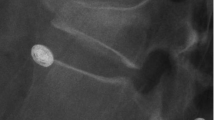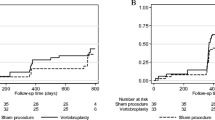Abstract
Two recent randomised controlled trials (RCT) published by the New England Journal of Medicine (NEJM) in 2009 comparing vertebroplasty to sham procedures have concluded that vertebroplasty is no more effective than injection of local anaesthetic at the pedicle entry point. This finding contradicts previously published clinical series on vertebroplasty which have shown clinical efficacy. The procedural details of the two RCTs are analysed specifically with regard to vertebral levels treated and injected polymethylmethacrylate (PMMA) volumes in an attempt to combine the data for assessment against the available basic science underpinning the effect of vertebral augmentation procedures. Neither investigation provides a breakdown of the vertebral levels treated in the original publication or in supplementary online material. Only one investigation provides information on fill volumes with an overall average fill volume of 2.8 ± 1.2 ml SD. The available basic science indicates a minimum fill volume of 13–16% of the vertebral body volume to be necessary for a relevant biomechanical effect on restoration of vertebral strength. The most commonly treated vertebrae of the thoracolumbar junction have an anatomical vertebral body volume of ~30 ml. An effective fill would require a minimum of ~4 ml PMMA. Anatomical volumes and required fill volumes increase towards the lower lumbar spine. According to the available basic science, only vertebrae of the upper to mid thoracic spine could reasonably have received a biomechanically effective fill with the declared average volume of 2.8 ± 1.2 ml SD. The available data of the NEJM publications strongly indicates that the treatment arm includes patients who were not treated in a reasonably effective manner. The technical information provided by the NEJM publications is insufficient to conclusively prove or disprove the clinical efficacy of vertebroplasty.
Similar content being viewed by others
References
Aebi M (2009) Vertebroplasty: about sense and nonsense of uncontrolled “controlled randomized prospective trials”. Eur Spine J 18:1247–1248
Al-Ali F, Barrow T, Luke K (2009) Vertebroplasty: what is important and what is not. Am J Neuroradiol 30:1835–1839
Álvarez L, Alcarez M, Pérez-Higueras A et al (2006) Percutaneous vertebroplasty: functional improvement in patients with osteoporotic compression fractures. Spine 31:1113–1118
Bono C, Heggeness M, Mick C, Resnick D, Watters W (2009) Newly released vertebroplasty randomized controlled trials: a tale of two trials. Spine J. doi:10.1016/j.spinee.2009.09.007
Boszczyk BM, Bierschneider M, Hauck S et al (2005) Transcostovertebral kyphoplasty of the mid and high thoracic spine. Eur Spine J 14:992–999
Buchbinder R, Osborne RH, Ebeling PR et al (2009) A randomized controlled trial of vertebroplasty for painful osteoporotic vertebral fractures. N Engl J Med 361:557–568
Buchbinder R, Osborne RH, Ebeling PR et al (2008) Efficacy and safety of vertebroplasty for treatment of painful osteoporotic vertebral fractures: a randomised controlled trial. BMC Musculoskelet Disord 9:156
Evans AJ, Jensen ME, Kip KE et al (2003) Vertebral compression fractures: pain reduction and improvement in functional mobility after percutaneous polymethylmethacrylate vertebroplasty—retrospective report of 245 cases. Radiology 226:366–372
Gray LA, Jarvik JG, Heagerty PJ et al (2007) Investigational vertebroplasty efficacy and safety trial (invest): a randomized controlled trial of percutaneous vertebroplasty. BMC Musculoskelet Disord 8:126
Homminga J, Weinans H, Gowin W, Felsenberg D, Huiskes R (2001) Osteoporosis changes the amount of vertebral trabecular bone at risk of fracture but not the vertebral load distribution. Spine 26:1555–1561
Jensen ME, Evans AJ, Mathis JM et al (1997) Percutaneous polymethylmethacrylate vertebroplasty in the treatment of osteoporotic vertebral body compression fractures: technical aspects. Am J Neuroradiol 18:1897–1904
Kallmes DF, Comstock BA, Heagerty PJ et al (2009) A randomized trial of vertebroplasty for osteoporotic spinal fractures. N Engl J Med 361:569–579
Kaufmann TJ, Trout AT, Kallmes DF (2006) The effects of cement volume on clinical outcomes of percutaneous vertebroplasty. Am J Neuroradiol 27:1933–1937
Keller TS, Kosmopoulos V, Lieberman IH (2005) Vertebroplasty and kyphoplasty affect vertebral motion segment stiffness and stress distributions—a microstructural finite-element study. Spine 30:1258–1265
Liebschner LA, Rosenberg WS, Keaveny TM (2001) Effects of bone cement volume and distribution on vertebral stiffness after vertebroplasty. Spine 26:1547–1554
Luo J, Daines L, Charalambous A, Adams MA, Annesley-Williams DJ, Dolan P (2009) Vertebroplasty: only small cement volumes are required to normalize stress distributions on the vertebral bodies. Spine 34:2865–2873
Molloy S, Mathis JM, Belkoff SM (2003) The effect of vertebral body percentage fill on mechanical behaviour during percutaneous vertebroplasty. Spine 28:1549–1554
Taylor RS, Fritzell P, Taylor RJ (2007) Balloon kyphoplasty in the management of vertebral compression fractures: an updated systematic review and meta-analysis. Eur Spine J 16:1085–1100
Tohmeh AG, Mathis JM, Fenton DC, Levine AM, Belkoff SM (1999) Biomechanical efficacy of unipedicular versus bipedicular vertebroplasty for the management of osteoporotic compression fractures. Spine 24:1772–1776
Wardlaw D, Cummings SR, Van Meirhaeghe J, Bastian L, Tillman JB, Ranstam J, Eastell R, Shabe P, Talmadge K, Boonen S (2009) Efficacy and safety of balloon kyphoplasty compared with non-surgical care for vertebral compression fracture (FREE): a randomised controlled trial. Lancet 373:1016–1024
Acknowledgments
No grants were received in support of this manuscript.
Conflict of interest
None.
Author information
Authors and Affiliations
Corresponding author
Rights and permissions
About this article
Cite this article
Boszczyk, B. Volume matters: a review of procedural details of two randomised controlled vertebroplasty trials of 2009. Eur Spine J 19, 1837–1840 (2010). https://doi.org/10.1007/s00586-010-1525-4
Received:
Accepted:
Published:
Issue Date:
DOI: https://doi.org/10.1007/s00586-010-1525-4




